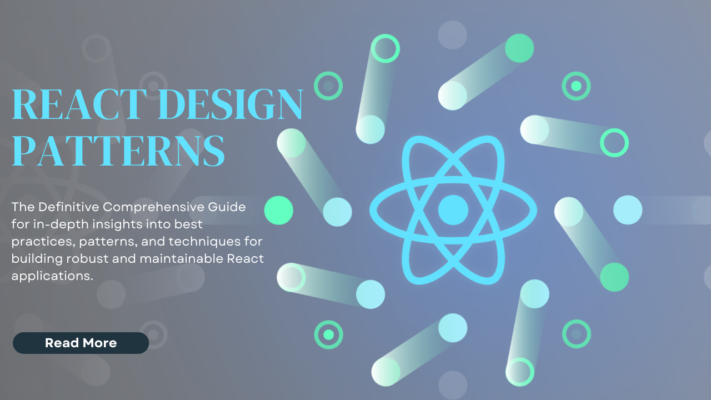
In the ever-evolving landscape of web development, React has emerged as one of the most popular and widely adopted JavaScript libraries. Its component-based architecture and efficient rendering mechanism have made it a go-to choice for building dynamic and performant user interfaces. However, as applications grow in complexity, adhering to best practices and design patterns becomes crucial for maintaining code quality, reusability, and scalability. Enter React design patterns – a set of proven solutions to common problems encountered in React application development. In this comprehensive blog post, we’ll delve into the world of React design patterns, exploring their benefits, popular patterns for 2024, and how following these patterns can elevate your React development game.
What is the React Design Patterns?
React design patterns are reusable solutions to common challenges faced when building React applications. These patterns provide a structured approach to organizing components, managing state, and handling data flow, ultimately leading to more maintainable, scalable, and efficient code. By leveraging design patterns, developers can avoid reinventing the wheel and benefit from the collective wisdom of the React community.
Design patterns in React are not limited to a specific set of rules or conventions; instead, they are flexible guidelines that can be adapted to suit the unique requirements of each project. These patterns often draw inspiration from proven software engineering principles and best practices, such as the principles of object-oriented programming, functional programming, and software architecture patterns.
What are the Benefits of Using React Design Patterns?
Adopting React design patterns offers numerous benefits that can significantly improve the development process and the overall quality of your applications. Here are some key advantages:
1. Reusability: Design patterns promote the creation of reusable components and code snippets, reducing duplication and fostering a more modular approach to development.
2. Maintainability: By following established patterns, your code becomes more readable, structured, and easier to maintain over time, even as your application grows in complexity.
3. Collaboration: Design patterns provide a common language and set of best practices, facilitating better communication and collaboration among team members.
4. Performance Optimization: Many React design patterns are specifically tailored to optimize performance by minimizing unnecessary re-renders, optimizing state management, and leveraging memoization techniques.
5. Future-proofing: As the React ecosystem continues to evolve, adhering to design patterns can help ensure that your codebase remains flexible and adaptable to new features and updates.
Leading React Design Patterns Patterns in 2024
As the React community continues to grow and innovate, new design patterns emerge while existing ones are refined and adapted to meet evolving needs. Here are some of the leading React design patterns that are expected to gain momentum in 2024:
1. Compound Components Pattern: This pattern enables the creation of flexible and composable components by leveraging React’s context API and render props, allowing for better code organization and reusability.
2. Higher-Order Components (HOCs): HOCs are a powerful pattern for reusing component logic by wrapping a component with another component that provides additional functionality or behavior.
3. Render Props Pattern: Similar to HOCs, the render props pattern allows for component composition and logic reuse by passing a render function as a prop to a component.
4. React Hooks: Introduced in React 16.8, hooks have revolutionized the way state and lifecycle methods are handled in functional components, leading to cleaner and more modular code.
5. Context API and Provider Pattern: React’s built-in Context API, combined with the Provider pattern, offers a powerful way to manage and share state across multiple components, reducing prop-drilling and promoting code reusability.
6. Styled Components: This pattern combines React components with CSS styles, enabling better encapsulation, reusability, and maintainability of styles within your components.
7. Code Splitting and Lazy Loading: As applications grow in size, lazy loading and code splitting patterns become essential for optimizing performance by loading only the necessary code chunks on demand.
8. React Server Components (RSCs): Introduced in React 18, RSCs aim to improve the performance and scalability of server-rendered React applications by enabling selective hydration and streaming rendering.
These patterns represent just a subset of the innovative solutions being developed within the React community, and they are likely to continue evolving and adapting to meet the changing demands of modern web development.
Why You Should Follow React Design Patterns?
Adopting React design patterns is not just a matter of following trends; it offers numerous tangible benefits that can significantly enhance the quality, maintainability, and scalability of your React applications. Here are some compelling reasons why you should embrace React design patterns:
1. Improved Code Quality: By following established patterns, your codebase becomes more organized, consistent, and easier to understand, leading to fewer bugs and better overall code quality.
2. Enhanced Collaboration: Design patterns provide a common language and set of best practices, facilitating better communication and collaboration among team members, especially in larger projects or when working with external developers.
3. Faster Development: By leveraging reusable components and patterns, you can reduce development time and effort, allowing you to focus more on delivering features and functionality.
4. Scalability and Maintainability: As your application grows in complexity, adhering to design patterns ensures that your codebase remains scalable, maintainable, and adaptable to future changes and requirements.
5. Community Support: By following widely adopted patterns, you can benefit from the collective knowledge and resources of the React community, including documentation, tutorials, and open-source libraries.
6. Future-proofing: The React ecosystem is constantly evolving, and by embracing design patterns, you can ensure that your codebase remains flexible and adaptable to new features, updates, and best practices.
How Can Upcore Help You React Design Patterns?
At Upcore Technologies, we understand the importance of leveraging industry best practices and design patterns to deliver high-quality, scalable, and maintainable software solutions. Our team of experienced React developers is well-versed in the latest React design patterns and their applications across various industries and project requirements.
By partnering with Upcore Technologies, you can benefit from our expertise in the following areas:
1. Consulting and Guidance: Our consultants can provide valuable insights and guidance on which React design patterns are most suitable for your specific project requirements, ensuring that your application is built on a solid foundation from the outset.
2. Custom Solution Development: Our skilled developers can work closely with you to design and develop custom React solutions that adhere to industry-leading design patterns, ensuring code quality, reusability, and maintainability.
3. Code Audits and Refactoring: If you already have an existing React codebase, our team can conduct a comprehensive code audit and provide recommendations for refactoring and implementing design patterns to improve performance, scalability, and maintainability.
4. Training and Knowledge Transfer: In addition to product development services, we offer comprehensive training programs to help your team stay up-to-date with the latest React design patterns, best practices, and emerging trends in the ecosystem.
At Upcore Technologies, we pride ourselves on delivering cutting-edge solutions that leverage the latest technologies and industry best practices. By combining our expertise in React design patterns with our deep knowledge of AI, machine learning, RPA solutions, and computer vision services, we can help you build innovative and future-proof applications that drive business growth and success.
Don’t let outdated practices or poorly structured codebases hold your React applications back. Partner with Upcore Technologies and unlock the full potential of React design patterns, ensuring your applications are built for scalability, maintainability, and long-term success.


